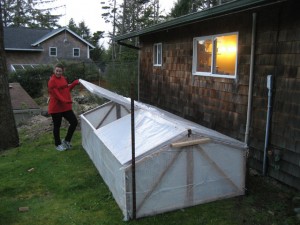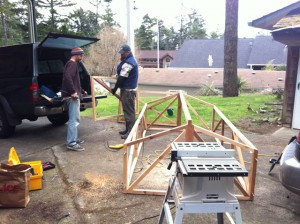 Back when I was in the Peace Corps, I came across a clever design for a mini-greenhouse. It wasn’t appropriate for what we needed at the time, but I filed the idea away in the back of my head. It had many good points- portable, so it could be picked up and set over a bed for temporary frost protection; panelized, so it could be stored in the winter; short; to keep the warmth down by the plants; and double-walled, to better insulate.
Back when I was in the Peace Corps, I came across a clever design for a mini-greenhouse. It wasn’t appropriate for what we needed at the time, but I filed the idea away in the back of my head. It had many good points- portable, so it could be picked up and set over a bed for temporary frost protection; panelized, so it could be stored in the winter; short; to keep the warmth down by the plants; and double-walled, to better insulate.
A few months back I ordered the plans for the mini-greenhouse from Ecology Action, the cool california-based agricultural research group that invented it. It’s just the ticket for covering my seedlings until the frost danger is past, can be used to give extra heat to the peppers and tomatoes in the late spring, and they will probably come in handy to cover whatever is still alive in the early fall when the frost danger returns. They are easy to pick up, and the 5’x10′ footprint is perfect for covering half a planting bed.
 We finally built it a few weeks back. The materials came to about $200 for the wood and ripstop plastic, and it took about three days to build, working at a leisurely pace. My old friends Brian and Ryan helped for a lot of it, and that was probably the most enjoyable part of all. I have always loved working on projects with good friends… chatting, telling stories, enjoying the sun. I guess that is one of my highest hopes for this whole farm business, to make it a place where friends can come and enjoy the pleasures of simple work with good company in a beautiful setting.
We finally built it a few weeks back. The materials came to about $200 for the wood and ripstop plastic, and it took about three days to build, working at a leisurely pace. My old friends Brian and Ryan helped for a lot of it, and that was probably the most enjoyable part of all. I have always loved working on projects with good friends… chatting, telling stories, enjoying the sun. I guess that is one of my highest hopes for this whole farm business, to make it a place where friends can come and enjoy the pleasures of simple work with good company in a beautiful setting.
A few days ago, I seeded the trays for our longest lead time produce: beets, peppers (both sweet and hot), and tomatoes (four varieties). I sowed just over over 2,000 seeds. “Man, what will I do with all this produce if it doesn’t sell?” I asked myself as I looked at all the flats. But then I remembered- in the odd chance that no one is buying (very unlikely around here), I could can a LOT of spaghetti sauce and salsa. And still have leftovers to give to the food bank.

